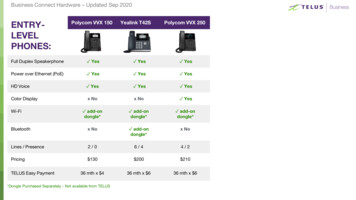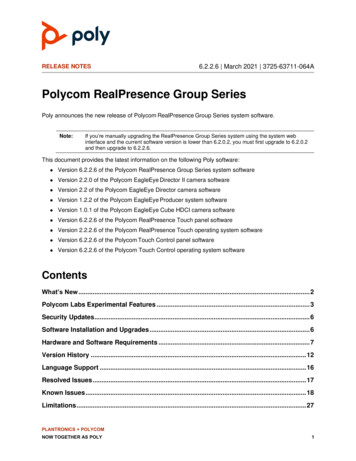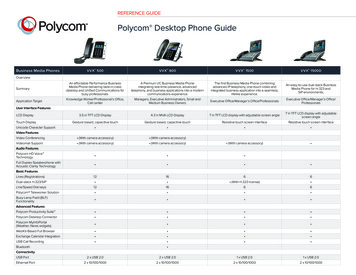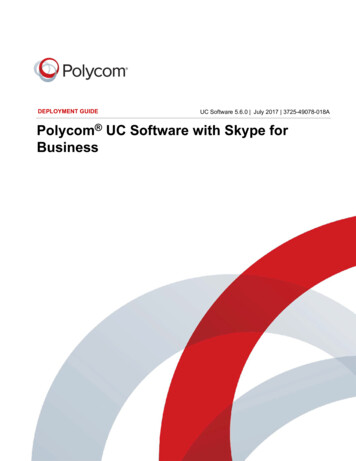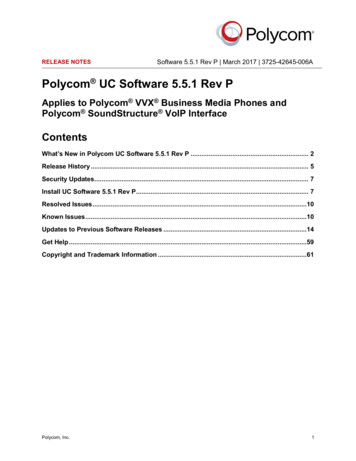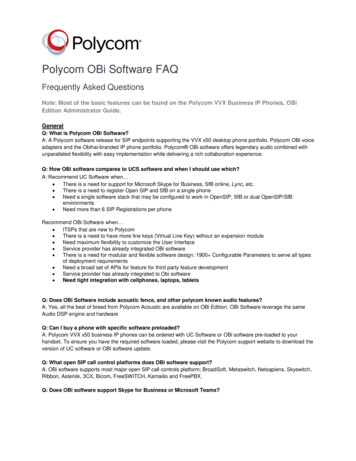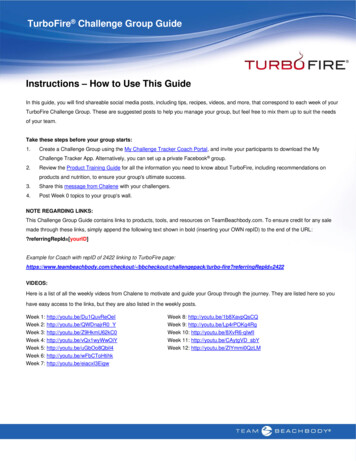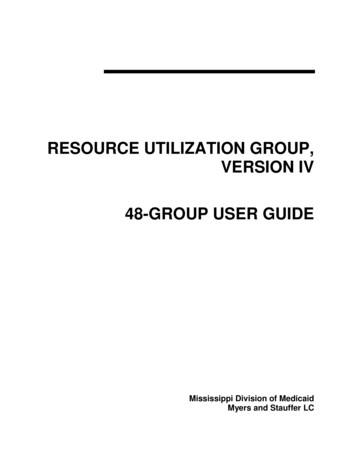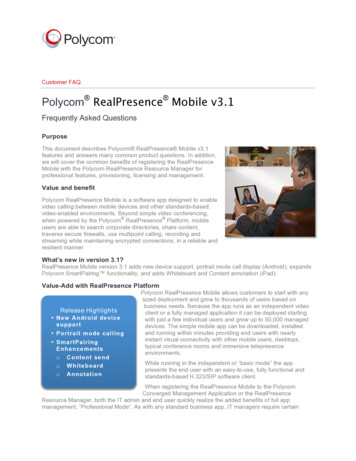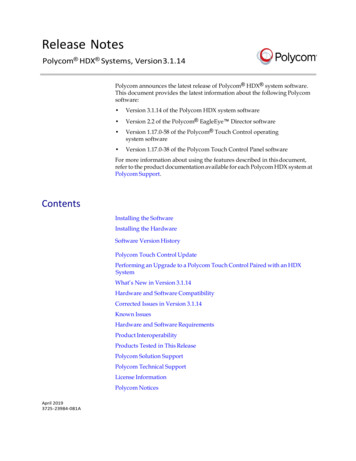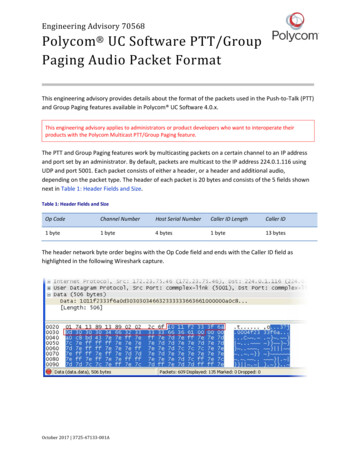
Transcription
Engineering Advisory 70568Polycom UC Software PTT/GroupPaging Audio Packet FormatThis engineering advisory provides details about the format of the packets used in the Push-to-Talk (PTT)and Group Paging features available in Polycom UC Software 4.0.x.This engineering advisory applies to administrators or product developers who want to interoperate theirproducts with the Polycom Multicast PTT/Group Paging feature.The PTT and Group Paging features work by multicasting packets on a certain channel to an IP addressand port set by an administrator. By default, packets are multicast to the IP address 224.0.1.116 usingUDP and port 5001. Each packet consists of either a header, or a header and additional audio,depending on the packet type. The header of each packet is 20 bytes and consists of the 5 fields shownnext in Table 1: Header Fields and Size.Table 1: Header Fields and SizeOp CodeChannel NumberHost Serial NumberCaller ID LengthCaller ID1 byte1 byte4 bytes1 byte13 bytesThe header network byte order begins with the Op Code field and ends with the Caller ID field ashighlighted in the following Wireshark capture.October 2017 3725-47133-001A
Engineering Advisory 70568UC Software PTT/Group Paging Audio Packet FormatHeader FieldsThis section describes each of the 5 fields found in the header.Op CodeThe Op Code field is 1 byte and provides information about the packet type. There are three packettypes: PTT Alert, PTT Transmit, and PTT End of Transmit. Use Table 2: Op Codes to match an Op Code tothe corresponding packet type and to understand the function of each packet type.Table 2: Op CodesOp CodePacket TypePacket Purpose0FPTT AlertThis packet signals all phones listening on the current channelthat a phone is about to begin broadcasting.10PTT TransmitThis packet is used to transfer audio data and is the onlypacket type which contains audio frames.FFPTT End of TransmitThis packet signals all phones that the broadcasting phone hascompleted its broadcast.Channel NumberThe channel number field is 1 byte and represents the channel that the packet is transmitted on. Thechannels range from 1 – 50, with channels 1 – 25 for PTT, and channels 26 – 50 for paging. ThePTT/Paging feature enables users to broadcast messages with a certain priority level: Normal, Priority, orEmergency. By default, the PTT feature treats channel 24 as a Priority channel and channel 25 as anEmergency channel while the Paging feature treats channel 49 as the Priority channel and channel 50 asthe Emergency channel. The Priority and Emergency channels can be changed by administrators.Host Serial NumberThe host serial number field is 4 bytes and represents the last 4 bytes of the serial number/MAC addressof the broadcasting phone. This field is used for contention resolution – when multiple phones beginbroadcasting on the same channel at the same time, the phone with the lowest serial number continuesto broadcast and all other phones will stop broadcasting. Any 32-bit number can be used in place of theserial number as long as its value is guaranteed to be unique among the multicast participants.Caller ID LengthThe caller ID length field is 1 byte and represents the number of bytes in the caller ID field. Although thepacket includes the caller ID length, the encoded length and length of the caller ID string are fixed at 13.Polycom, Inc.
Engineering Advisory 70568UC Software PTT/Group Paging Audio Packet FormatCaller IDThe caller ID field is 13 bytes and consists of a text string (a phone’s extension for example) thatidentifies the broadcasting phone. If this string is less than 13 bytes, it is terminated with a null.Otherwise, if this field is null, the value from reg.1.displayName (found in the reg-basic.cfg file) willbe used. If that too is null, the phone’s MAC address will be used. A receiving phone displays the callerID on its screen.Audio DataAudio data is only present in a PTT Transmit packet. There are two codecs which can be used to send theaudio data:1 G.722 – Typical audio payload is 240 bytes (30ms)2 G.711u – Typical audio payload is 240 bytes (30ms)Audio data consists of a 6 byte audio header followed by two frames of audio data. The first frame is aredundant frame—it contains a copy of the audio from the previous packet. The second frame containsthe current audio. The only exception is the first PTT Transmit packet, which will not contain aredundant audio frame. An example Audio Header is shown next in Table 3: Audio Header ExampleTable 3: Audio Header ExampleNumber of BytesDescriptionNotes1Codec Type0x00 means G.711µ0x09 means G.7221Flags ByteNot applicable4Sample CountRTP timestamp for the second audio frame (except for the firstPTT transmit packet, then it’s for the first and only audioframe)PTT/Page SessionA PTT or Page is initiated by sending 31 PTT Alert packets at approximately 30 millisecond intervals,followed by the transmission of the audio data in PTT Transmit packets. Upon completion of the Page,after a 50 millisecond delay, 12 PTT End of Transmit packets are sent at approximately 30 millisecondintervals completing the Page.Polycom, Inc.
Engineering Advisory 70568UC Software PTT/Group Paging Audio Packet FormatExample Page SessionThe following example shows a Wireshark capture of a short paging session, specifically a PTT session,using the G.711µ codec with a 20 msec sample size (resulting in an audio frame of 160 bytes). A differentPTT session will contain a different number of bytes (and packets).The following tables (Tables 4 to 12) provide packet details of the entire audio frame (187 packets).Included is: Packet number and type Transmit time in seconds Source and destination IP addresses Protocol used VLAN formation Packet contents—Highlighted contents are explained in detailIn some instances, the packet contents are a repeat of previous packets. These are noted in thefollowing tables.Table 4: First PTT Alert PacketPktNo.Time(seconds)Source IPAddressDestination IPAddressProtocolVLAN Info10.000000192.168.1.103224.0.1.116UDPSource port: complex-linkDestination port: complex-link000000100020003001 00 5e 00 01 74 00 04 f2 11 15 11 08 00 45 0000 30 16 71 00 00 40 11 c0 c8 c0 a8 01 67 e0 0001 74 13 89 13 89 00 1c 90 63 0f 1a f2 11 15 110d 4d 65 6c 6f 64 79 20 4d 65 73 65 72 76. .t.E.0.q.@.g.t.c.Melody MeservAlert packetHighlighted contents described intable belowTable 5: Contents of PTT Alert PacketField ValueNumber of BytesField NameNotes0f1Op CodePTT Alert1a1Channel Number26 (first channel in paging range)Polycom, Inc.
Engineering Advisory 70568UC Software PTT/Group Paging Audio Packet FormatField ValueNumber of BytesField NameNotesf2 11 15 114Host Serial NumberLast four bytes of phones MACaddress (004f2111511)0d1Caller ID Length134d 65 6c 6f 6479 20 4d 65 7365 72 7613Caller IDMelody MeservTable 6: Remainder of PTT Alert PacketsPktNos.Time(seconds)Source IPAddressDestination IPAddressProtocolVLAN Info2 - 31every 0.030(approx.)192.168.1.103224.0.1.116UDPSource port: complex-link0000001000200030Destination port: complex-link01 00 5e 00 01 74 00 04 f2 11 15 11 08 00 45 0000 30 16 71 00 00 40 11 c0 c8 c0 a8 01 67 e0 0001 74 13 89 13 89 00 1c 90 63 0f 1a f2 11 15 110d 4d 65 6c 6f 64 79 20 4d 65 73 65 72 76. .t.E.0.q.@.g.t.c.Melody MeservRepeat of Packet 1After the 32 PTT Alert packets, the actual data transmission starts with the PTT Transmit packets.Table 7: First PTT Transmit PacketPktNo.Time(seconds)Source IPAddressDestination IPAddressProtocolVLAN Info320.969281192.168.1.103224.0.1.116UDPSource port: complex-linkDestination port: complex-linkPolycom, Inc.
Engineering Advisory 70568UC Software PTT/Group Paging Audio Packet 06000700080009000a000b000c000d000e0Source IPAddressDestination IPAddress01 00 5e 00 01 74 00 04 f2 11 15 11 08 00 45 0000 d6 16 90 00 00 40 11 c0 03 c0 a8 01 67 e0 0001 74 13 89 13 89 00 c2 65 76 10 1a f2 11 15 110d 4d 65 6c 6f 64 79 20 4d 65 73 65 72 76 09 006f ca 7b f5 5e 7a f7 70 f4 7a 5e db f2 5e d7 dcf5 f8 ef fb 5c 6d b1 9f b9 9d b9 b3 f3 9d f9 f379 f6 dd f4 9f df fb f2 b3 fb 76 f6 ba d7 fb b8de 59 f8 f8 b2 fa dc dc fb df 9b 5f f9 d8 dd b7b8 f9 5d f9 df f9 9d f5 f9 f7 bb 79 f7 9d f5 75f9 f5 9f f9 fb fb f2 f9 79 f9 b7 fb bb df f7 f7f9 b9 f9 f9 5f 76 b9 f6 b9 6e ea a8 6d f1 f3 9ddf 75 76 9c d7 fa ba 5d da 7e 57 99 dc 98 de f4f3 30 f4 f7 b8 de df f4 73 bb 7e 78 fa da 99 f9df 5b de da 5e 5f bc 9c f7 bc 78 f8 79 b4 6d f4fc fb fa bcProtocol. .t.E.@.g.t.ev.Melody Meserv.o.{. z.p.z . .\m.y.v.Y. .].y.u.y. v.n.m.uv.]. W.0.s. x.[. .x.y.m.VLAN Info1st PTT Transmit packetHighlighted contents described intable belowTable 8: Contents of First PTT Transmit PacketField ValueNumber of BytesField NameNotes101Op CodePTT Transmit1a1Channel Number26 (first channel in paging range)f2 11 15 114Host Serial NumberLast four bytes of phones MACaddress (004f2111511)0d1Caller ID Length134d 65 6c 6f 6479 20 4d 65 7365 72 76 0913Caller IDMelody Meserv001CodecG.711 µ6f1FlagsNot applicableca 7c 95 5e4RTP Sequence number7a f7 70 f4 7a.160Audio framePolycom, Inc.
Engineering Advisory 70568UC Software PTT/Group Paging Audio Packet FormatTable 9: Second PTT Transmit PacketPktNo.Time(seconds)Source IPAddressDestination IPAddressProtocolVLAN Info330.989055192.168.1.103224.0.1.116UDPSource port: complex-linkDestination port: 01600170018001 00 5e 00 01 74 00 04 f2 11 15 11 08 00 45 00 . .t.E.00 d6 16 90 00 00 40 11 c0 03 c0 a8 01 67 e0 00 .@.g.01 74 13 89 13 89 00 c2 65 76 10 1a f2 11 15 11 .t.ev.0d 4d 65 6c 6f 64 79 20 4d 65 73 65 72 76 09 00 .Melody Meserv.6f ca 7b f5 5e 7a f7 70 f4 7a 5e db f2 5e d7 dc o.{. z.p.z . .f5 f8 ef fb 5c 6d b1 9f b9 9d b9 b3 f3 9d f9 f3.\m.79 f6 dd f4 9f df fb f2 b3 fb 76 f6 ba d7 fb b8y.v.de 59 f8 f8 b2 fa dc dc fb df 9b 5f f9 d8 dd b7 .Y. .b8 f9 5d f9 df f9 9d f5 f9 f7 bb 79 f7 9d f5 75 .].y.uf9 f5 9f f9 fb fb f2 f9 79 f9 b7 fb bb df f7 f7.y.f9 b9 f9 f9 5f 76 b9 f6 b9 6e ea a8 6d f1 f3 9d . v.n.m.df 75 76 9c d7 fa ba 5d da 7e 57 99 dc 98 de f4 .uv.]. W.f3 30 f4 f7 b8 de df f4 73 bb 7e 78 fa da 99 f9.0.s. x.df 5b de da 5e 5f bc 9c f7 bc 78 f8 79 b4 6d f4 .[. .x.y.m.fc fb fa bc d7 5f 7b 5a ba f8 be d8 79 f4 dc bb . {Z.y.75 f7 fe f9 78 71 9f b9 71 f5 9d 5f f8 7e d9 bcu.xq.q. . .ba 5e dd db 7a 5b b0 f6 f0 df 77 78 b5 b9 f4 f2 . .z[.wx.79 fc 5f 73 bc 9f f9 f9 f6 57 fc 79 b8 fc f8 bay. s.W.y.fe fc fa 73 fc db f5 f7 9d 76 fe fa 9e ba 78 7e.s.v.x fe dc de b8 d9 fb f3 de b8 f6 38 fb 9f f3 f5 f7.8.f8 74 71 9b 7c b8 fa de fe de f3 5e b4 f1 f8 76 .tq. . .vb8 b8 fc de 75 75 f7 f8 fe be 5c 99 9f 75 7b 7a .uu.\.u{zf6 9f 78 f8 f8 fb dd f1 f5 fb fb f2 78 de f3 9e.x.x.f6 9e 7b f5 b8 de f2 7a 97 b7 de f8 75 b7 78 b4 .{.z.u.x.5c fa f1 fa2nd PTT Transmit packetHighlighted contents described intable belowTable 10: Contents of Second PTT Transmit PacketField ValueNumber of BytesField NameNotes101Op CodePTT Transmit1a1Channel Number26 (first channel in paging range)f2 11 15 114Host Serial NumberLast four bytes of phones MACaddress (004f2111511)0d1Caller ID Length13Polycom, Inc.
Engineering Advisory 70568UC Software PTT/Group Paging Audio Packet FormatField ValueNumber of BytesField NameNotes4d 65 6c 6f 6479 20 4d 65 7365 72 76 0913Caller IDMelody Meserv001CodecG.711 µ6f1FlagsNot applicableca 7c 95 5e4RTP Sequence number7a f7 70 f4 7a.160Audio frameRedundant frame (duplicate of lastframe in previous packet)d7 5f 7b 5a ba.160Audio frameNew audio frameThe remainder of the PTT Transmit packets (34 - 174) are transmitted every 30 milliseconds. Each packetwill contain two audio frames: A duplicate of the last audio frame from the previous packet A new audio frameThe data transmission is complete. The end of the broadcast is signaled by 12 PTT End of Transmitpackets.Table 11: End of PTT Transmission PacketsPktNo.Time(seconds)Source IPAddressDestination IPAddressProtocolVLAN e port: complex-linkDestination port: complex-link000000100020003001 00 5e 00 01 74 00 04 f2 11 15 11 08 00 45 0000 30 17 1e 00 00 40 11 c0 1b c0 a8 01 67 e0 0001 74 13 89 13 89 00 1c a0 62 ff 1a f2 11 15 110d 4d 65 6c 6f 64 79 20 4d 65 73 65 72 76. .t.E.0.@.g.t.b.Melody MeservEnd of Transmission packetHighlighted contents described intable belowTable 12: Contents of End of PTT Transmission PacketField ValueNumber of BytesField NameNotesff1Op CodePTT End of TransmitPolycom, Inc.
Engineering Advisory 70568UC Software PTT/Group Paging Audio Packet FormatField ValueNumber of BytesField NameNotes1a1Channel Number26 (first channel in paging range)f2 11 15 114Host Serial NumberLast four bytes of phones MACaddress (004f2111511)0d1Caller ID Length134d 65 6c 6f 6479 20 4d 65 7365 72 7613Caller IDMelody MeservPolycom, Inc.
Engineering Advisory 70568UC Software PTT/Group Paging Audio Packet FormatCopyright 2017, Polycom, Inc. All rights reserved. No part of this document may be reproduced, translated intoanother language or format, or transmitted in any form or by any means, electronic or mechanical, for any purpose,without the express written permission of Polycom, Inc.6001 America Center DriveSan Jose, CA 95002USAPolycom , the Polycom logo and the names and marks associated with Polycom products are trademarks and/orservice marks of Polycom, Inc. and are registered and/or common law marks in the United States and various othercountries. All other trademarks are property of their respective owners. No portion hereof may be reproduced ortransmitted in any form or by any means, for any purpose other than the recipient's personal use, without the expresswritten permission of Polycom.End User License Agreement BY USING THIS PRODUCT, YOU ARE AGREEING TO THE TERMS OF THEEND USER LICENSE AGREEMENT (EULA) AT: http://documents.polycom.com/indexes/licenses. IF YOU DO NOTAGREE TO THE TERMS OF THE EULA, DO NOT USE THE PRODUCT, AND YOU MAY RETURN IT IN THEORIGINAL PACKAGING TO THE SELLER FROM WHOM YOU PURCHASED THE PRODUCT.Patent Information The accompanying product may be protected by one or more U.S. and foreign patents and/orpending patent applications held by Polycom, Inc.Open Source Software Used in this Product This product may contain open source software. You may receivethe open source software from Polycom up to three (3) years after the distribution date of the applicable productor software at a charge not greater than the cost to Polycom of shipping or distributing the software to you. Toreceive software information, as well as the open source software code used in this product, contact Polycom byemail at OpenSourceVideo@polycom.com.Disclaimer While Polycom uses reasonable efforts to include accurate and up-to-date information in this document,Polycom makes no warranties or representations as to its accuracy. Polycom assumes no liability or responsibility forany typographical or other errors or omissions in the content of this document.Limitation of Liability Polycom and/or its respective suppliers make no representations about the suitability of theinformation contained in this document for any purpose. Information is provided “as is” without warranty of any kindand is subject to change without notice. The entire risk arising out of its use remains with the recipient. In no eventshall Polycom and/or its respective suppliers be liable for any direct, consequential, incidental, special, punitive orother damages whatsoever (including without limitation, damages for loss of business profits, business interruption,or loss of business information), even if Polycom has been advised of the possibility of such damages.Customer Feedback We are striving to improve our documentation quality and we appreciate your feedback. Emailyour opinions and comments to DocumentationFeedback@polycom.com.Visit the Polycom Support Center for End User License Agreements, software downloads, product documents,product licenses, troubleshooting tips, service requests, and more.Polycom, Inc.
This packet signals all phones that the broadcasting phone has completed its broadcast. Channel Number . The channel number field is 1 byte and represents the channel that the packet is transmitted on. The channels range from 1 – 50, with chan
